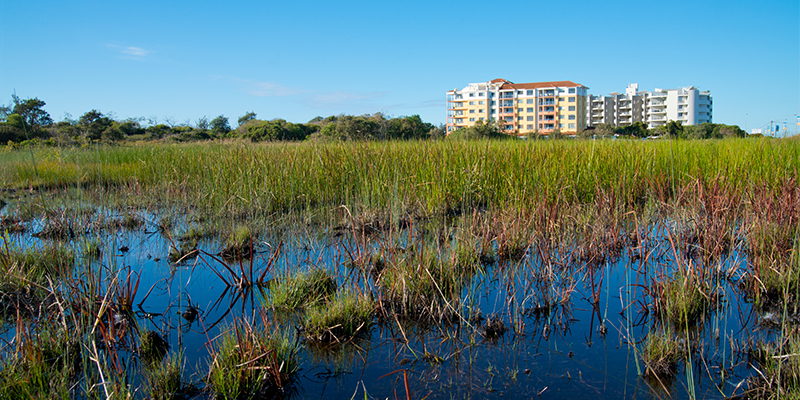NAIOP members and their firms may have a brief opportunity to secure exemptions from federal water regulations, following the recent overhaul of a landmark environmental statute. The new regulatory regime, which went into effect on June 22, narrows the scope of federal jurisdiction over the nation’s waterways, replacing the much broader Obama-era rule from 2015. The window for action is rapidly closing, however, as more than a dozen states and environmental groups have filed lawsuits in an effort halt the rule’s implementation.
The debate over which wetlands and waterways receive federal protection dates back to 1972, the year President Richard Nixon signed the Clean Water Act into law. That statute mandated the protection of “navigable waters,” defined simply as “the waters of the United States (WOTUS), including the territorial seas.” Much to the chagrin of a wide array of stakeholders, it offers no further clarification.
As a result, for the better part of five decades, regulators have been engaged in a seemingly never-ending quest to design rules that appropriately interpret this language, while balancing the need for environmental conservation with economic development. But while intended to provide clarity, many of the regulations promulgated over the years have only added to the confusion of what is – and is not – under federal jurisdiction.
The judiciary has also played a central role in defining the scope of WOTUS, though not without drawing its own share of controversy. The regulations are somewhat unique; unlike lawsuits over Clean Air Act rules, which are heard by the U.S. Court of Appeals for the District of Columbia Circuit, WOTUS suits can land in any of the nation’s roughly 100 federal district courts. This dynamic makes it easier for plaintiffs to potentially block new rules from going into effect.
Court rulings themselves have contributed to the ambiguity as well. Notably, in the 2006 Rapanos Supreme Court plurality opinion, Justice Antonin Scalia argued for a narrow WOTUS definition that encompassed “relatively permanent, standing, or continuously flowing bodies of water.” A concurring opinion, written by Justice Anthony Kennedy, instead argued that WOTUS includes wetlands with a “significant nexus” to traditionally navigable waters. That muddled ruling created a confusing legal precedent that remains hotly contested to this day.
The Obama administration’s WOTUS rule adopted this vague standard of “significant nexus,” applying it largely on a case-by-case basis. When it was published in 2015, a group of 31 states and other plaintiffs challenged the regulation in federal courts. Over the next four years, several federal district courts blocked the new rule. The result was a jurisdictional patchwork, in which 22 states were governed by the 2015 rule, with the remaining states under regulations from the 1980s.
Fast forward to 2020, when the Trump White House codified its own replacement rule. In a formal comment letter submitted at the time, NAIOP commended the efforts of regulators, and offered recommendations to provide even further clarity to affected landowners.
Called the Navigable Waters Protection Rule (NWPR), its structure made it easier to for federal agencies to issue speedy decisions. Rather than the in-person, case-by-case analysis required by the Obama-era WOTUS definition, the NWPR better enables the Army Corps of Engineers (the Corps) to use satellite imagery and rainfall records to issue findings. With clearer rules and a decreased reliance on field visits, decisions in some cases can take days, rather than years. Lawsuits were immediately filed in eight different states to block the change nationwide. A Colorado court halted the rule within the state; the outcome of the remaining suits is still pending.
Because the Navigable Waters Protection Rule could be stayed at any time by one of several federal courts, businesses are moving quickly to secure regulatory decisions under the current regulatory regime before it’s too late. Specifically, firms are seeking jurisdictional determinations (JD) from the Corps, a regulatory decision that is typically valid for five years. With a JD in hand, developers and landowners can effectively hedge against the risk of changes to the scope of WOTUS in the future, whether due to court decisions, elections or other events.
The Corps is working overtime to issue these determinations at a rapid pace. Since June, the agency has issued over 1,000 determinations, roughly 70 percent of which found that the waters in question were not federally protected, according to an analysis conducted by Bloomberg Law. In addition, the EPA and Corps have issued a series of memos on how to apply the rule consistently, in an effort to further streamline the process.
It’s unclear how long this window of opportunity will remain open. Legal experts speculate that justices will hold off on issuing rulings until after the November elections, but that is far from a sure thing. States are also ramping up efforts to protect wetlands no longer covered under the rule, adding yet another potential roadblock for developers. And, finally, Democrats have hinted at eliminating the Senate filibuster rule if they take control of Congress and the White House, presenting yet another scenario in which the Navigable Waters Protection Rule could be reversed. Given the uncertain landscape, it’s no surprise that businesses are rushing to lock in jurisdictional determinations while they still can.














